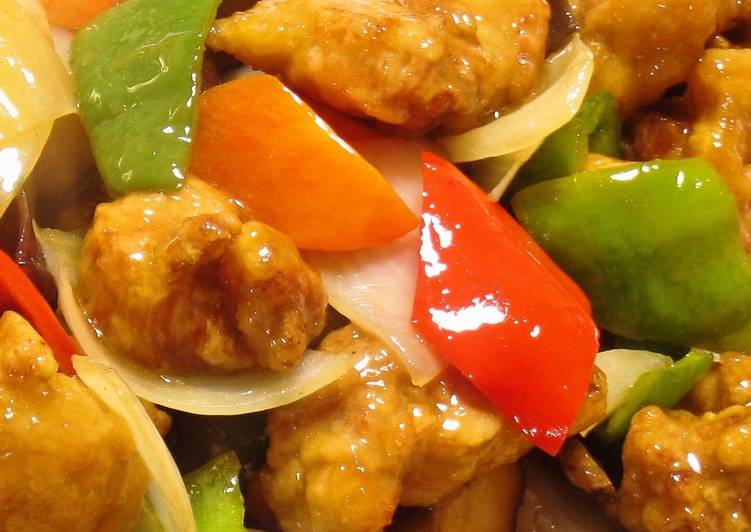Black Vinegar Sweet & Sour Pork. Less sweet than balsamic but with more depth than white wine vinegar, black vinegar is a staple in Chinese cuisine. Here's why, plus how you should use it in your cooking. This has a nice, slightly smoky, slightly sweet, almost plum-like, piquant flavoring that makes it a great complementary component for a variety of dishes.
 Sweetened black vinegar is very different and has added sugar and flavorings, usually including ginger.
This ingredient is used primarily for braised pork dishes.
Chinkiang vinegar is typically black and has a malty and complex taste.
You can cook Black Vinegar Sweet & Sour Pork using 22 ingredients and 11 steps. Here is how you achieve that.
Sweetened black vinegar is very different and has added sugar and flavorings, usually including ginger.
This ingredient is used primarily for braised pork dishes.
Chinkiang vinegar is typically black and has a malty and complex taste.
You can cook Black Vinegar Sweet & Sour Pork using 22 ingredients and 11 steps. Here is how you achieve that.
Ingredients of Black Vinegar Sweet & Sour Pork
- Prepare 350 grams of Thinly sliced pork belly.
- You need 1/2 of Carrot.
- It's 1/2 of Onion.
- You need 2 of Green peppers.
- Prepare 1 of Red bell pepper.
- You need 1 of Dried shiitake mushrooms.
- You need 1 of as much (to taste) Wood ear mushrooms.
- It's 1 tbsp of Sesame oil.
- You need of Pork seasonings.
- You need 1 tbsp of Shaoxing wine.
- Prepare 1 dash of Salt and pepper.
- You need of Sweet vinegar sauce.
- It's 6 tbsp of Black Vinegar.
- Prepare 3 tbsp of Sugar.
- It's 2 tbsp of Soy sauce.
- You need 1 tbsp of Shaoxing wine.
- You need 1 tbsp of Oyster sauce.
- It's 6 tbsp of Soaking liquid from the dried shiitake mushrooms.
- It's 1 tbsp of Katakuriko.
- Prepare of For the batter.
- Prepare 1 of Egg.
- It's 5 tbsp of Katakuriko.
Black vinegar is less acidic than regular white vinegar; slightly sweet as well. It's somewhat similar to balsamic vinegar. The best quality Chinese black vinegar is aged for several years and displays a complex, smoky depth of flavor. Chinese black vinegar is widely used in Chinese cooking for all types of cold appetizers, braised meats and fish, noodles and as a dipping condiment for dumplings.
Black Vinegar Sweet & Sour Pork instructions
- Cut 5 mm deep 3 mm wide slits into the pork, then cut into 2-3 cm chunks..
- Sprinkle the meat with the sake, salt, and pepper and rub into the meat to season. Let sit for 15 minutes, cutting the vegetables while you wait..
- Mix the sweet vinegar sauce ingredients beforehand. Mix well. Add the katakuriko..
- Rehydrate the wood ear mushrooms in water, remove the stems, and cut. Rehydrate the shiitake mushrooms in hot water for at least 3 hours, then slice into 1 mm..
- Cut the onions, green peppers, and carrots. Parboil the carrots in hot water for 3-5 minutes..
- Beat the egg well, then mix in the katakuriko. Soak the pork thoroughly in the mixture..
- Heat the oil to 170℃ and fry the pork. Once crispy, drain the oil..
- Turn the oil down to 160℃, then add the green peppers, then the onions, then the carrots into the oil and fry for about 15 seconds..
- Put the sweet vinegar sauce in a wok, then turn the heat to medium. Once thickened, add the vegetables and pork, increase the heat to high, and coat with the sauce..
- Drizzle 1 tablespoon of sesame oil around the edge of the wok, stir it up, and serve..
- It's a little expensive, but sweet & sour pork is best when made with black vinegar..
It can be used to add acidity and sweetness to braised dishes like Chinese Braised Fish, where it cooks down to sweet black gold. The flavor of Chinese black vinegar is complex and mellow, sweet, smoky, malty and full bodied. It's less tangy than other kinds of rice vinegar and less sweet than balsamic vinegar. The flavor profile and quality varies considerably by brand and age. Substitutes for Chinese Black Vinegar Chinese black vinegar—known usually in its most popular form, Chinkiang or Zhenjiang vinegar—is deeply colored and tastes fruity (though it's less sweet than balsamic), with a touch of umami richness.